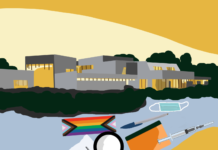The University of Waterloo has purchased two 3-D printers that are available to students and located in the 3-D Print Centre inside the Engineering 5 building.
The two printers were presented to an audience of students, staff, and interested parties during the Engineering/Retail Services 3-D Print Centre Launch Nov. 11. The event featured a tour of the 3-D Print Centre, a didactical exhibition of 3-D printed artifacts, tools, and a fully 3-D printed Magnetic Resonance Imagining machine. The event also featured keynote speaker James Janeteas, the president of Cimetrix Solutions, who talked about the applications and future of the 3-D printing industry.
The two printers are now part of the new media services. According to the 3-D Print Centre website, “The 3-D Print Centre at the University of Waterloo provides low cost, high quality rapid prototyping and lends used parts to students, staff, and faculty, with a focus on undergraduate students and teams.”
As stated by the website, the 3-D Print Centre features “two in-house production-grade fused deposition modeling 3-D printers as well as access to other 3-D printing technologies through our 3-D printing partner, Hyphen, based in Kitchener.” Both of the printers use Fused Deposition Models, which is an additive manufacturing technology commonly used for modeling, prototyping, and production applications. FDM works on an “additive” principle by laying down material in layers; a plastic filament or metal wire is unwound from a coil and supplies material to produce a part.
The standard materials used for printing are either Polycarbonate-Acrylonitrile Butadiene Styrene (PC-ABS) or Acrylonitrile Butadiene Styrene (ABS) as well as Polycarbonate (PC). Each of the materials have their advantages and limitations. Polycarbonate has the greatest heat resistance and strength; the designs printed on this material tend to be more accurate but it is not a flexible material. ABS is flexible as well as coming in many colours, but it is not as strong as other materials. Meanwhile PC-ABS combines the strength of the polycarbonate with the flexibility of ABS, making it the most popular 3-D printing material.
The 3-D Print Centre is available to all UW students, all you need to print your design is to create a CAD (Computer-Aided Design) model, save it as a .stl file, and take it to the 3-D Print Centre where an operator will help you select the best material for your part.
The 3-D Print Centre received it first order Jan. 2013 and has been widely used by undergraduate students as well as graduate researcher students, and local startups. Peter Teertstra, the director of the Sedra Student Design Centre, stated the reasons why the University of Waterloo decided to purchase the 3-D printers.
“Originally it was looking at student projects and they really needed a way to manufacture the parts that they were thinking of. They were trying to make things in masking tape or duct tape when they really needed to have access to a 3-D printer to make their dreams come true and build their parts.”
A lot of fourth-year engineering students have taken advantage of the 3-D printing services since its first order in January 2013.
“The whole idea was to give students the ability to make the parts that they were able to design in their heads and on their computers…and to do it affordably” Teertstra said.
While most engineering students are aware of the 3-D print services, some students from other faculties are still unaware to the accessibility of these services.
“Most students in engineering are aware that we have a 3-D printer, what I really hope to achieve with this event and with bringing retail services on board is to make the rest of the campus aware that we have 3-D printing available to them.”
In an interview with Janeteas, he shared what he believes to be the limitations with the current 3-D printing industry.
“I think the limitations come in a couple of formats, one of them is the education. Organizations and industries really does not understand what the applications of 3-D printing are, so that is always a challenge. Organizations need to learn and allow their designers to learn how to design in additive manufacturing, another term for 3-D printing, to really leverage it…secondly the system still needs to become faster and more reliable, and provide consistent yield rates in order for them to be really true production-based systems,” Janeteas said.
The last part of the event featured a contest to name the printers. The two names chosen were Wall-E and Eve.































